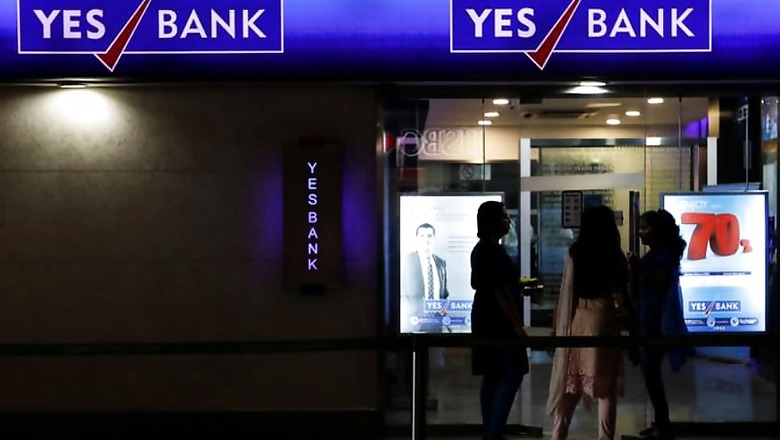
views
New Delhi: Did the sudden RBI takeover of India’s fourth-largest private bank, which was reeling under bad loans and whose collapse looked imminent, come in a bit too late? The RBI superseded the board of YES Bank late on Thursday, restricting withdrawal of deposits to Rs 50,000 per account holder, placing the bank under a moratorium for a month and then bringing in state-owned SBI with a rescue plan.
While these actions would prevent a run on YES Bank and ensure safety of depositors’ hard-earned money — which may have been lost otherwise — it is pertinent to question the timing of the central bank’s move. Not the least because in this instance once again, the government has allowed socialisation of private losses by nudging SBI to come to the rescue. SBI has promised immediate infusion of Rs 2,450 crore, while expecting more investors to come on board eventually.
Experts agree that despite SBI stepping in and RBI’s measures to stabilise things at YES Bank, there could still be large-scale withdrawal by depositors due to erosion of confidence in the bank’s ability to safeguard their money.
So, why did the RBI not move earlier, despite being a witness to several warning signs at YES Bank? There were numerous negotiations between the YES Bank management and potential investors about equity infusion but they all nearly always collapsed inexplicably. Why did alarm bells not ring at this turn of events? The government would have us believe that it smelt a scam in the frequent breakdown of talks with potential investors and actually did the smart thing by enticing back co-promoter Rana Kapoor from London before eventually closing his options and taking over the tottering bank.
Kapoor has been arrested, a detailed Enforcement Directorate probe is underway and amid Opposition allegations of going soft on the goings on at YES Bank, the government has assured depositors that their money is safe.
But there’s no gainsaying the fact that the regulator (RBI is both the central bank and the sector regulator) was missing in action as months rolled by.
Take, for example, the assurance that CEO & MD Ravneet Gill gave to analysts during a conference call to discuss Q2 results as late as on November 1. Gill said the bank had received a “binding” offer for $1.2 billion from a “global” investor and also referred to the successful completion of a QIP a few months before, through which the bank raised $273 million, to showcase how things were going on the right track.
Not just this one “binding” equity infusion offer, Gill showed no hesitation in also referring to several other so-called offers which were allegedly already on the table. The impression one gleaned from Gill’s comments was of a bank which was in high demand among the investing community. He emphasised that this bid had come “with the backing of a large long-standing US financial institution”. And then went on to talk about eight “very strong” bids from top global private equity firms and some domestic firms being on the table.
“If you look at these eight bids, they themselves aggregate to over $ 1.5 billion. In addition, as I had mentioned when we had connected earlier during the month, there were three constituencies of investors that we were looking at. One was, obviously, the private equity, which is the piece that I just covered. Second one was family offices, and third one was more strategic.”
Gill hinted at support from two of India's “most sophisticated financial investors, very large, very highly pedigreed, very highly respected. And equally, we have support from two of India's finest entrepreneurs known for their business acumen, their leadership, their governance standards. And just looking at these four, the demand over there could be in the vicinity of $350 million”.
As we now know, not one investor finally bit the bullet and YES Bank remained starved of capital, with NPAs rising beyond the 7.39 per cent or Rs 17,134 crore number disclosed as of September 30.
Not only were analysts being told about numerous potential investors in the fray, chief risk officer Ashish Agarwal was simultaneously giving out an assurance about the bank reducing exposure to stressed sectors such as NBFCs, housing finance companies and real estate.
“The bank has seen an overall reduction in absolute terms of around Rs 1,750 crore for Q2 FY20 and has seen further reductions of close to Rs 1,500 crore post-September 30. The bank has also not incrementally underwritten any new meaningful corporate real-estate exposure, and has seen an absolute reduction in terms of the overall outstanding to this sector,” Agarwal said during the same conference call.
He also referred to the bank’s exposure to the beleaguered telecom sector — where the overall outstanding of YES Bank was around 3 per cent of its total loan book, predominantly to two operators. “We continue to monitor the developments in this sector very closely, including the recommendations which probably would be made by the Committee of Secretaries for ensuring that the credit profile of some of the telecom companies remain intact.”
Yet another question and its answer during the call should be of interest. One analyst wanted to know what the bank would do if one housing company, whose auditors had alleged Rs 20,000 crore worth of siphoning off, was to default on repayments to the bank? Neither the analyst nor the management named the company and it is likely that the reference was to DHFL, where allegations of a large-scale siphoning off had surfaced by then after a forensic audit by KPMG. Exposure to DHFL is since known to be one of the major reasons for YES Bank’s current state of affairs.
During that call, Chief Risk Officer Agarwal had responded to the analyst’s question thus: “See, as you are aware, the bond exposure is mark-to-market. So the bank continues to carry the mark-to-market provision on this particular name that you are talking about. The entire exposure of the bank to this company is in the nature of investments. So we have been following RBI guidelines with respect to that, and we have been marking it to market. So depending on where the bond gets traded, if indeed the siphoning and fraud et cetera is proven and it is classified as fraud, we will need to provide, again, in line with RBI guidelines, which could be as high as 100%. However, that is something, which has not happened as yet. So we continue to do a mark-to-market provision on these bonds.”
Now, as SBI takes up to 49% equity stake at YES Bank and the regulatory agencies simultaneously book Kapoor for alleged wrongdoing, one can only hope that depositors in other weak private banks are spared such agony. And that RBI overhauls its regulatory oversight mechanism to prevent more YES Banks from becoming NO Banks.
















Comments
0 comment